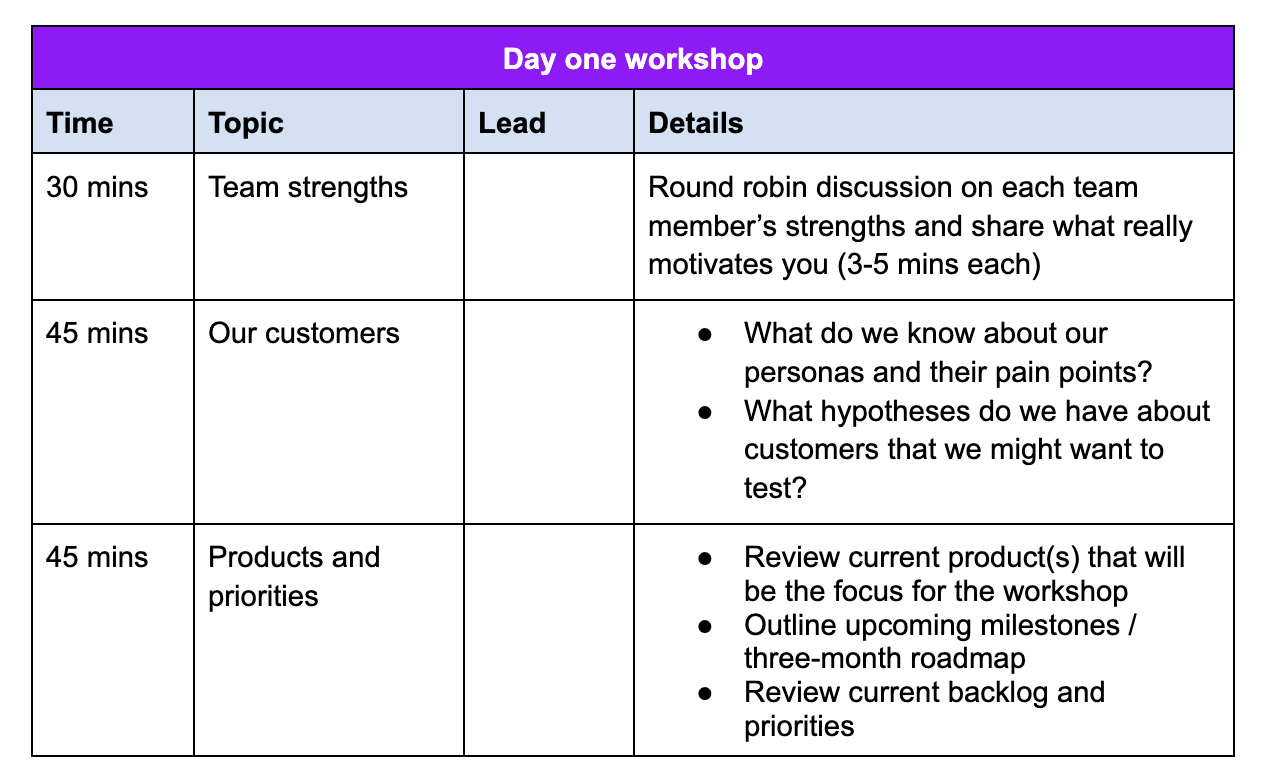Steal my startup approved growth workshop agenda
When an old friend and colleague of mine recommended the book “Growth Levers and How to Find Them,” by Matt Lerner, I expected yet another business book that promised dramatic results within 100 pages and a quick two to three hour read. I’m talking about the kind of book that gets you all excited, only to leave you feeling deflated when you realize you can’t influence your organization enough to make the necessary changes.
And it might’ve been just that if I hadn’t cared to take action. Instead, I took what I learned in the book and applied it directly to my team. In fact, this book inspired me so much, I’ve read it multiple times and bought it for all of my team members.
When you think about the typical responsibilities for “growth,” product might not be the first thing that comes to mind. You probably think of business development, sales, marketing, or occasionally someone with “growth” in the title. The reason this book resonated with me as a product person is that we have to grow product adoption for our startups to grow.
Certainly, there are layers of growth to explore on top of the core product (e.g., business development, international expansion, partnerships), but the core product has a foundational role in establishing and, later, stabilizing that growth.
At digital tech companies, the product is often the primary driver of business. There are, of course, services companies where the “product” is the professional services available to customers. Lerner’s book has many themes that could be applied to both types of businesses, but for the purposes of this article, we’ll assume the goal is to grow the business by increasing adoption and engagement with a product — digital or physical.
With that background in mind, let’s explore how to take the learnings from “Growth Levers” and transform them into an actionable workshop for your team that’s tactical enough to execute tomorrow.
How I set up my workshops
At my last company and in my current role, I bought a copy of the book for everyone on my team, asked them to read it, and held a workshop to discuss it and craft our strategy accordingly.
The workshop agenda requires two days, preferably in person, and it worked so well the first time I repeated this at my second startup, with similar results — the team was aligned, inspired, and prepared for immediate action by the end of day two.
Make sure you delegate each section of the agenda to a different person on your team. This ensures that everyone has equal responsibility in preparing for and facilitating the meeting, and it shows you trust and rely on them to hold their weight when it comes to product planning and execution.
The example below walks you through how to best implement a growth workshop within your own product team.
Share workshop goals
You should always start by aligning on the goals you want to accomplish. We decided on the following:
- Map our growth model, as well as identify North Star metrics and key drivers to prioritize the 10 percent of ideas that can generate 90 percent of our results
- Evaluate the customer journey and where we should focus 80 percent of our time and effort to reach our desired outcomes of adoption, usability (lovability), and revenue generation. Identify the growth lever(s) we believe we can pull to move the needle on those key drivers
- Identify specific experiments we can run based on the definition of the above
Day 1 focus areas
- Our team strengths
- Our customers
- Our products and North Star metrics (NSMs)
- Key drivers
- Sketch the growth model
Day 2 focus areas
- Identify growth levers
- Identify the rate limiting step (RLS)
- Growth Sprint Planning with Hypotheses and Experiment Ideas
Day 1 agenda
Establish a common understanding of where you are, where you’re going, what you need to discover, and what each team member brings to the table.
- Morning (2 hrs)
- 30 mins: Team strengths — Round robin discussion on each team member’s strengths and share what really motivates you (3-5 mins each)
- 45 mins: Our customers — What do we know about our personas and their pain points? What hypotheses do we have about customers that we might want to test?
- 45 mins — Products and priorities — Review current product(s) that’ll be the focus for the workshop. Outline upcoming milestones / three month roadmap. Review current backlog and priorities
- Pre-lunch (45 mins)
- 45 mins: Identify North Star metrics (NSMs) — The number that ultimately tracks value delivered to customers and causes revenue. According to the book, it should increment when we deliver value to the customer; earn money and grow the company if we succeed in moving it; represent the results of optimizing the entire customer journey from first contact through retention / churn; keep increasing forever; and be something everyone in the company understands, remembers, and uses to guide their work
- Afternoon (2.5 hours hrs)
- 50 mins: Identify three key drivers for each NSM — These are results of the work people do to move the North Star. If key drivers are successful, they lead to positive movement on the NSM. Key drivers aren’t the work to be done — it’s the outcome we want from the work we’ll do. Each key driver will be supported by specific actions
- 90 mins: Sketch the growth model — Draw / map the growth model, where boxes are absolute numbers (e.g., number of visitors, sign-ups, etc.) and arrows represent conversion percentages (e.g., conversion from step one to step two of your customer journey). The map includes the key drivers we identified, plus more. The NSM is highlighted on the map as part of the journey / growth model
Day 2 agenda
Brainstorm ideas to get you to your end state and identify the current blocker (rate-limiting step) holding you back from growth.
- Morning (3 hrs)
- 60 mins: Identify the growth levers — What work needs to be done to move the key drivers and boost the north star? Create a table of three to four items for each Key Driver we can try to move the needle on the Key Drivers, which in turn moves the needle on the NSM. Set targets around results rather than work units
- 20 mins: Identify the rate limiting step (RLS) — What’s the bottleneck that constrains the overall growth rate? If we focus resources anywhere else before removing this RLS, our efforts will have limited impact. Identify the top RLS for each product right now (5 mins each)
- 90 mins: Growth sprint planning | RESULT: 15 experiments we can test now (or soon)
- Run a brainstorming session for seven minutes asking for all ideas on “How might we… [increase X, discover Y, etc.]” based on what we identified earlier
- Team review of ideas (20 mins)
- Vote on the top five things we want to try to answer that align to our key drivers and growth levers (10 mins)
- Brainstorm all the experiments we could run for each of those five things (5 mins each, so 5×5 = 25 mins on this part)
- Vote on the top three experiments we can run for each of the five priorities (10 mins)
- Afternoon (2.5-3 hrs)
- 60 mins: Experiment priorities and planning — Identify which experiments we’ll test in what priority order. Identify an owner for each and set a target milestone
- 60-90 mins: Design thinking rapid sketch session — Taking the top two to three things we want to test, begin conceiving of UX ideas. In design thinking fashion, all members sketch and contribute ideas, then we discuss and vote on the top ones we want to prototype and test with users
- 20 mins: Wrap-up and actions — Communicate what we’ve learned to the rest of the business. Define a lead to package parts of the materials and put it into a presentation format for the company to understand what we achieved and how we approached it
Downloadable workshop template
To make it even easier for you to implement, I’ve created this downloadable template to help you plan your team’s growth workshop:
What it looked like in reality
This workshop model worked like a charm for us. People brought their books in person, and some of them were already highlighted or flagged with stickies on key pages.
During the sessions, we flipped through the pages, confirming our understanding of a key driver, for example, so we could align on a common framework for how the book’s examples applied to our use case. It’s important to confirm a common definition early on terms like this, since effective communication increases confidence, job satisfaction, and productivity.
Some of our deep-dive sessions overran a bit, and we ended up using more of our time available in the afternoon to brainstorm and map things out, but I still believe the target times I set on the agenda are appropriate as a starting point. You can negotiate the timing as needed.
Our outcomes
By the end of both workshops, we had actionable hypotheses to test, such as new features we thought could address the rate-limiting step (RLS), which soon were designed, spec’d, and developed.
After measuring one of them for a few months, it turns out we were right — at least one of them does increase engagement by making it easier for users to take action!
Applying this workshop to your team
When adapting this to your team, consider variables like location, people, roles, and motivations. Don’t be afraid to look beyond the product team at your organization to support and/or lead segments of this workshop agenda.
Be clear up front about your intention and goals for the workshop, your expectation of others to actively lead segments of it, and the outcomes you know are possible.
If you have a hard time prioritizing the ideas generated from the workshop among your existing roadmap, use a model like RICE (reach, impact, confidence, effort), or another common product prioritization framework, to evaluate them relative to one another and make a data-driven decision about what to develop first.
If you find your team in a rut in another few months, run it again. Otherwise, sustain momentum along the way by encouraging habitual hypothesis generation and testing among your team. This could look like reserving a ten minute segment of a regular team meeting to discuss experiments the team is running to test and validate hypotheses generated during or after the workshop.
Final thoughts
Reading “Growth Levers” inspired my idea for this workshop, which I’ve run at two startups within the last two years. The two-day agenda brings people together to understand each other’s strengths and sketch the growth model for your product such that everyone walks away with a clear understanding of the North Star metric, key drivers, and growth levers to test. Get started by filing out the template here.
The work doesn’t end after the workshop. The main intent is to instill a sense of collaboration, wonder, and hypothesis-driven development (HDD) in your team so that everyone feels empowered, informed, and walks away with a clear understanding of how they can contribute to your company’s (and/or product’s) growth strategy on a daily basis.
Featured image source: IconScout
The post Steal my startup approved growth workshop agenda appeared first on LogRocket Blog.
This post first appeared on Read More



